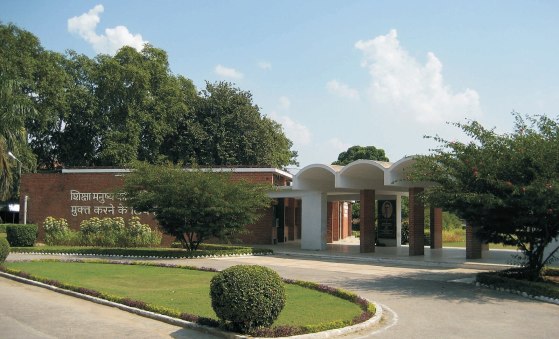
The national capital woke up to a thick grey haze on Wednesday, two days after Diwali celebrations, with air quality deteriorating to ‘very poor’ and ‘severe’ levels across multiple monitoring stations. Those in what has been called the world’s most polluted city once again found themselves breathing dangerously toxic air. Dark clouds shrouded the city as residents continued to breathe polluted, toxic air. Visibility fell sharply, the air smelled acrid, and people complained of watery eyes and breathing discomfort.
The city’s Air Quality Index (AQI) stood at 341 as of 1 pm on 22 October, according to the Central Pollution Control Board (CPCB). Out of 39 monitoring stations in Delhi, 31 recorded AQI levels between 301 and 399, classified as ‘very poor’. West Delhi’s Punjabi Bagh reported the worst air quality with an AQI of 419, placing it in the ‘severe’ category. Nehru Nagar also entered the severe zone with an AQI of 401.
Area-wise readings showed Anand Vihar at 363, Chandni Chowk at 325, ITO at 372, and Najafgarh at 301. High pollution levels in the ‘very poor’ range were reported in Okhla, Sirifort, Ashok Vihar, Dwarka Sector 8, Bawana, Mathura Road, Pusa, North Campus, around Jawaharlal Nehru Stadium and Dilshad Garden. The lowest AQI was recorded at Lodhi Road and DTU at 209, which still makes the air in these areas ‘poor’.
Average concentrations of particulate matter (PM 2.5) across several parts of the city crossed 400 micrograms per cubic metre, levels not recorded since 2021. On Diwali day, Delhi entered the ‘severe’ category when PM 10 and PM 2.5 concentration of suspended particulate matter peaked at 675, PTI reported. Air pollution shot up to 100 times World Health Organisation limits at several locations, with PM 2.5 levels reaching 1,753 micrograms per cubic metre at Nehru Vihar at 10 pm on Monday, about 116.8 times the WHO permissible limit of 15 micrograms per cubic metre. At Patparganj, levels hit 1,144.8 micrograms per cubic metre at 4 am on Tuesday, over 76 times the WHO limit.
An independent analysis by Climate Trends, a weather and climate agency, showed a drastic increase in PM 2.5 levels in Delhi between 4 pm and 11 pm on Diwali (20 October). The level rose from 150 to almost 650 micrograms per cubic metre during the evening hours when firecrackers were burst. Ground data confirmed that burning so-called ‘green’ crackers made no measurable difference compared to regular ones.
This year’s pollution surge followed the Supreme Court’s decision to allow green firecrackers in Delhi-NCR, responding to a request from the BJP-led Delhi government. Chief Minister Rekha Gupta had approached the court earlier in October, arguing that complete bans on firecrackers in previous years had not yielded desired results and violations continued, leading to use of highly polluting firecrackers. The government sought permission for certified green crackers as a balanced approach between public sentiment and environmental concerns.
The apex court permitted the use of green crackers on Diwali within a limited timeframe of 8 pm to 10 pm. However, massive violations of the rule were noted. The toxic spike was caused by the sheer quantity of fireworks as well as insufficient supply of green crackers. Sales of non-permitted firecrackers were also reported despite regulations.
Experts said weather conditions aggravated the situation. Despite relatively warm night temperatures of 23 to 25 degrees Celsius, low wind speeds trapped pollutants near the ground, preventing their dispersion. However, relatively quicker dispersal of pollution occurred due to higher than predicted wind speeds. “The pollution peaked between 12 am and 4 am and fell quickly due to high wind speed and high ventilation. As Diwali is earlier than usual, temperatures have not dropped drastically and wind speed is also higher,” said a scientist at the Indian Institute of Tropical Meteorology, Pune. “The wind speed was around 5 to 10 km per hour around midnight and this was more than what was predicted. This flushed out the pollutants immediately.” The morning on Wednesday witnessed mist and haze, with the India Meteorological Department recording a minimum temperature of 21.8 degrees Celsius, 3.4 notches above normal. Relative humidity was 91 per cent at 8.30 am.
The pollution crisis extended beyond Delhi. Data released by CPCB indicated that nine out of 293 cities surveyed reported a high AQI of above 300, classified as ‘very poor’, on Diwali night. The next day, this increased to 16 cities, with the majority of them in North India and the Indo-Gangetic plains. On Tuesday, 21 October, Dharuhera in Haryana registered the worst AQI of 462. By Wednesday morning, the same town recorded an AQI of 393 at 7.10 am. Other cities in the National Capital Region and Haryana dominated the list, with Jind at 386, Narnaul at 370, Charkhi Dadri at 364, and Rohtak at 350. Delhi and Yamuna Nagar shared the sixth position with an AQI of 345.
Several data points went missing in official records for the intervening night between Monday and Tuesday, raising questions from activists about the authenticity of data. Hourly data of PM 2.5 for many stations were missing when pollution was at its peak between 11 pm and 3 am, as per Delhi Pollution Control Committee’s website. “PM2.5 crossed 1,000 micrograms per cubic metre in Delhi last night, yet official air pollution data went missing at peak hours. If we lose data on the worst nights, how can CPCB ensure accurate pollution reporting?” said Bhavreen Kandhari, an environmental activist. Gufran Beig, chair professor at National Institute of Advanced Studies and founder-director of SAFAR, said a plausible explanation is that actual pollution levels were beyond the scale of measurement. “The missing data has led to underestimation of AQI. So, the actual AQI will be more than what the CPCB is reporting,” he said.
The pollution episode came despite Stage II of the Graded Response Action Plan (GRAP) being imposed across Delhi-NCR by the Commission for Air Quality Management. Under GRAP 2, twelve preventive measures are undertaken to mitigate air pollution, including stricter enforcement on restrictions related to diesel generator sets, restricting interstate buses (other than EVs, CNG, and BS-VI diesel) from entering Delhi, and enhancement of parking fees to discourage use of private transport. The BJP government blamed stubble burning in AAP-ruled Punjab for the rising pollution levels in Delhi.
A political blame game erupted over the pollution crisis. AAP accused the BJP government of shutting down pollution monitoring stations and manipulating Air Quality Index data on Diwali night to conceal the situation. AAP’s Delhi unit chief Saurabh Bharadwaj alleged the government “committed data theft at a government level” by showing AQI readings of around 350 when actual levels had crossed 1,700. “Multiple monitoring stations operated by the Central Pollution Control Board, Delhi Pollution Control Committee, India Meteorological Department and IITM went offline at the same time and came back only after the winds cleared the air. This is dishonesty and manipulation against the people of Delhi,” he claimed.
Environment Minister Manjinder Singh Sirsa responded by accusing the AAP government of Punjab of forcing farmers to burn crop residue. “Farmers in Punjab are being forced to burn stubble in the fields by the AAP government. The highest number of stubble burning incidents occurred in AAP-ruled Punjab on Diwali night,” he said. Bharadwaj countered by demanding an apology for what he called “a shameful attempt to communalise pollution”, claiming stubble burning incidents had reduced by nearly 90 per cent compared to 2021 and its contribution to Delhi’s pollution was “less than one per cent”.
Meanwhile, Delhi’s much-awaited artificial rain experiment continues to be on hold. Delhi Environment Minister Manjinder Singh Sirsa told PTI that there were no suitable clouds for the trial, according to the IMD, and no window is expected until 25 October. “The day we get suitable clouds, we will conduct the trial immediately, as all preparations, from permissions to flight arrangements, are already in place,” he said.
The Delhi government’s cloud seeding project, a major commitment by the BJP-led administration, was initially scheduled for July but has been postponed multiple times due to monsoon, changing weather patterns, disturbances, and now the lack of suitable cloud cover. An aircraft fitted with cloud-seeding equipment is stationed in Meerut under the supervision of a team from IIT Kanpur. Last month, the Delhi government signed a Memorandum of Understanding with IIT Kanpur for five cloud seeding trials expected to be conducted in northwest Delhi.
Different monitoring systems produced vastly different figures. While CPCB placed the AQI at around 351, global tracker IQAir reported readings above 2,000 in some parts of the city. The disparity stems from differences in methodology, with CPCB capping readings at 500 while IQAir’s US-based system allows higher values. Experts advised citizens to focus on category labels rather than numbers, noting both platforms reflect that Delhi’s air falls within the most dangerous bracket.
The IMD has forecast mist and haze in the morning hours with mainly clear skies during the rest of the day. The maximum temperature is expected to settle at 33 degrees Celsius.




